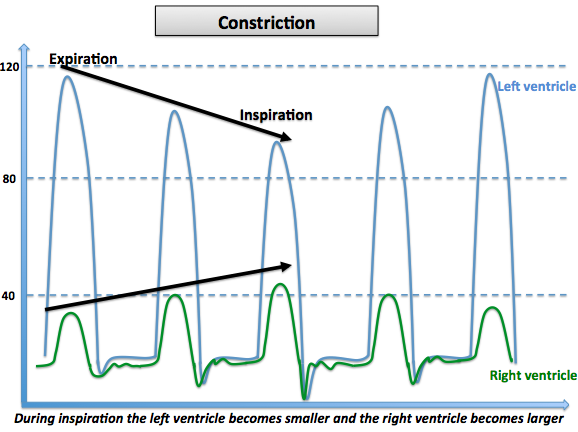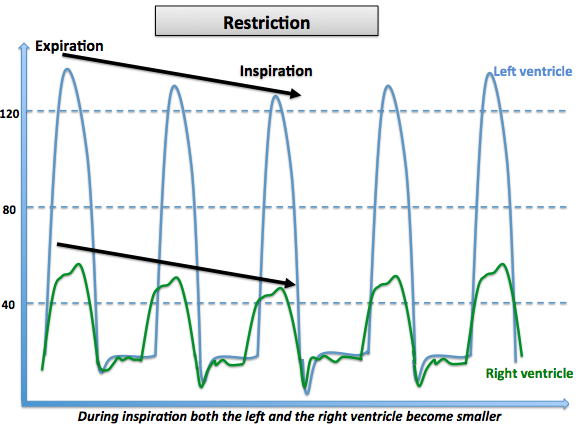Constrictive pericarditis differential diagnosis
Template:Pericardial constriction Editor-In-Chief: C. Michael Gibson, M.S., M.D. [1]
Overview
Constrictive pericarditis must be differentiated from restrictive cardiomyopathy. The evaluation of ventricular interdependence between the two ventricles is the best objective method to distinguish the two syndromes.
Pathophysiology
Both syndromes are associated with abnormalities in left ventricular filling. In patients with constriction, this is due to constriction of filling of the left ventricle by the pericardium. In restriction, there is impaired relaxation of the left ventricle.
Ventricular Interdependence
Ventricle interdependence is the effect of the size, shape and compliance of one ventricle on the size, shape and compliance of the other ventricle. These effects are most apparent with respiration or with sudden postural changes. Whereas diastolic ventricular interdependence is mainly mediated through the pericardium, systolic ventricular interdependence is mediated through the interventricular septum as well as through the pericardium.
The clinical importance of ventricular interdependence is in the differentiation between constrictive pericarditis and restrictive myocarditis as both of them present with symptoms of right heart failure.
Ventricular interdependence is assessed in the cardiac catheterization laboratory. In this test, the systolic pressure generated in the left ventricle is compared to that in the right ventricle during inspiration. During inspiration, there is negative intrathoracic pressure, and increased filling of the right ventricle.
Constriction
Among patients with constrictive pericarditis, with inspiration, there is increased filling of the right ventricle and given that it is constrained by the pericardium, the systolic pressure in the right ventricle rises. There is bulging of the septum into the left ventricle, and reduced filling of the left ventricle, and therefore the pressure drops in the left ventricle. The RV enlarges, and the LV gets smaller during inspiration.
Shown below is an image illustrating the changes in the size of the left and right ventricles during respiration in the case of constrictive pericarditis.

Restriction
Among patients with restrictive cardiomyopathy, there is an equal decline in LV and RV systolic pressures during inspiration.
Shown below is an image illustrating the changes in the size of the left and right ventricles during respiration in the case of restrictive cardiomyopathy.

E prime velocity
Both syndromes are associated with abnormalities in left ventricular filling. In patients with constriction, this is due to constriction of filling of the left ventricle by the pericardium. In restriction, there is impaired relaxation of the left ventricle.
Constriction
The E prime velocity is normal as there is no impediment to relaxation of the left ventricle.
Restriction
The E prime velocity is low (5 or below) in restriction due to impaired filling of the ventricle due to impaired relaxation.
Other Findings Favoring Constriction
- History of radiation, breast cancer, Hodgkins disease, prior heart surgery
- When there are signs and symptoms of heart failure out of proportion to myocardial or valve abnormalities
- There is respiratory variation on Doppler ultrasound
- There is septal shift with inspiration
- BNP is not very elevated
- The left atrium is not enlarged
Other Findings Favoring Restriction
- Large or giant atrial due to impaired left ventricular filling.
Complete Differential Diagnosis
In many cases, constrictive pericarditis is a late sequela of an inflammatory condition of the pericardium. The inflammatory condition is usually an infection that involves the pericardium, but it may be after a heart attack or after heart surgery.
Almost half the cases of constrictive pericarditis in the developing world are idiopathic in origin. In regions where tuberculosis is common, it is the cause in a large portion of cases.
Several conditions produce signs and symptoms that are similar to those generated by pericarditis, including life threatening conditions such as myocardial infarction, aortic dissection and pulmonary embolism. The conditions with similar symptoms to constrictive pericarditis include:
- Amyloidosis
- Atrial Myxoma
- Cardiac Cirrhosis
- Cardiac Neoplasms, Primary
- Caridac Sarcoma
- Cardiac Tamponade
- Cardiomyopathy, Dilated
- Cardiomayopathy, Restrictive
- Hemochromatosis
- Nephrotic Syndrome
- Ovarian Cancer
- Pericardial Effusion
- Pericarditis, Acute
- Pericarditis, Constrictive-Effusive
- Pericarditis, Uremic
- Sarcoidosis
- Superior Vena Cava Syndrome
- Tricuspid Regurgitation
- Tricuspid Stenosis
- Uremia
References